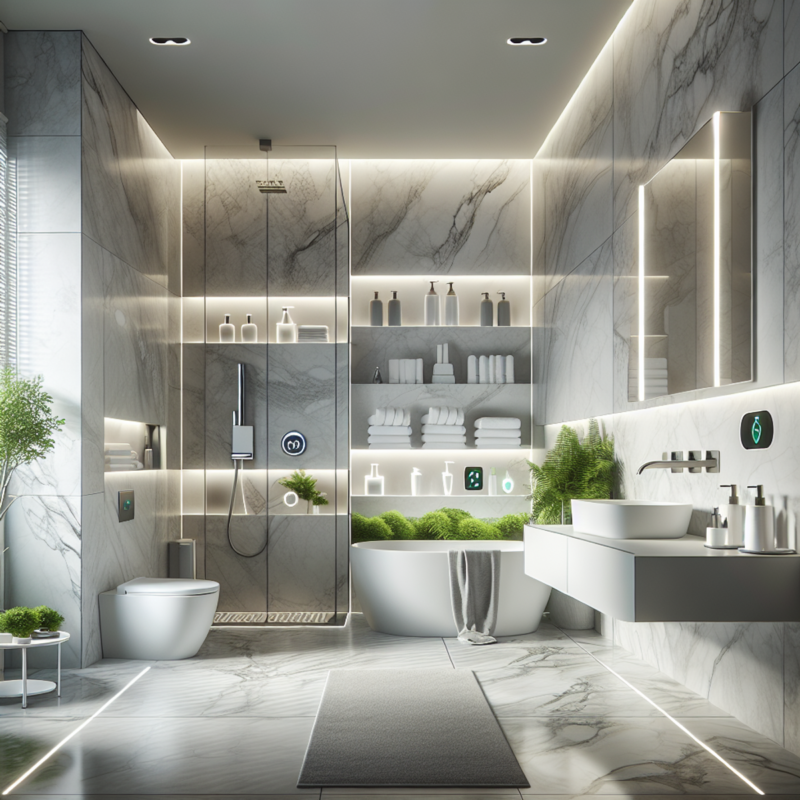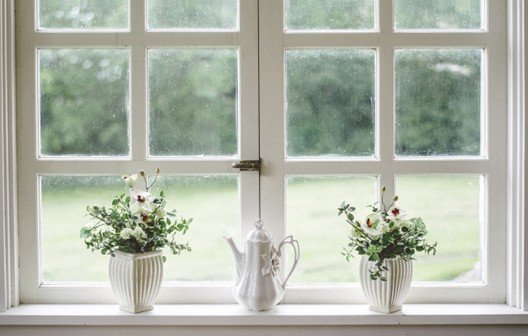Table of Contents Show
Introduction
Welcome to your ultimate guide for 2024 on bathroom renovation tips and tricks! Whether you’re looking to increase the value of your home, update its style, or simply make your daily routines more enjoyable, a bathroom renovation can be a game-changer.
It’s not just about picking out new tiles or fixtures; it’s about crafting a space that reflects your style while delivering the comfort and efficiency you deserve.
In this guide, we’ll navigate through an ocean of choices and considerations to transform your bathroom into a haven.
What You’ll Learn in This Guide
We will cover:
- The art of planning a functional and stylish makeover
- Budget-setting strategies without compromising quality
- Space optimization for those cozy powder rooms
- Lighting and ventilation for a fresh, airy feel
- Universal design principles for accessibility
- Tile selection wisdom—balancing beauty with durability
- Vanity choices that marry style with storage needs
- Investing in high-quality fixtures for longevity
- Neutral palettes with dashes of color vibrancy
- Tips for adding luxurious touches without breaking the bank
- Embracing cutting-edge smart technology
Plus, insights on how different levels of remodels affect resale value.
Ready to dive in? Let’s get started on creating a space that makes every day feel like a visit to the spa.
Assessing Your Bathroom Needs
Before diving headfirst into a bathroom renovation, it’s crucial to take a step back and assess your current bathroom condition. This process involves identifying the strengths and areas for improvement in your space. Here’s how:
Evaluating the existing layout
Note down the features you love, alongside those that are not quite hitting the mark. Maybe your shower is spacious enough, but the sink area feels cramped. Or perhaps you’re satisfied with your vanity unit but feel the need for more storage options.
Identifying problem areas
Keep an eye out for any signs of wear and tear or functional issues that need immediate attention:
- Leaky faucets
- Cracked tiles
- Peeling paint
- Poor ventilation
Next comes setting your renovation goals based on this evaluation. Consider these points:
Prioritizing needs vs wants
While a rainfall shower head might be tempting, it may not be as essential as fixing that persistent leak in your sink. A successful renovation balances aesthetics with functionality.
Aligning with lifestyle requirements
If you frequently rush in the mornings, a double sink setup could save precious time. Similarly, if relaxing baths are part of your self-care routine, investing in a luxurious tub makes sense.
By carefully assessing your bathroom needs, you’ll ensure your renovation project is guided by clear goals that enhance both the form and function of your space.
1. Planning Your Bathroom Makeover

Embarking on a bathroom renovation requires meticulous planning to ensure every new element harmonizes with your lifestyle and aesthetic preferences. Here’s how you can lay the groundwork for a transformative bathroom remodel:
Essential Steps for Planning Your Renovation
Start by assessing the dimensions and layout of your space to determine what can be changed or improved. Create a scaled floor plan, which can include everything from where your new fixtures will go to electrical outlets.
- Research & Inspiration: Gather ideas from design platforms and magazines to pinpoint the look you’re going for.
- Functionality First: Consider who uses the bathroom and how. Identifying these patterns helps tailor the design to fit daily routines.
- Professional Consultation: Even if you’re a DIY enthusiast, consulting with a contractor or designer can provide invaluable insights into structural considerations and potential hurdles.
Choosing Fixtures: Style Meets Function
Selecting fixtures isn’t just about beauty; it’s about combining style with practical function. Aim for fixtures that reflect your style but also cater to efficiency and ease of use.
- Faucets: Look for water-saving models that match your sink and shower layout.
- Toilets: Consider comfort height and eco-friendly flush options.
- Bathtubs & Showers: Decide between a quick shower setup or a luxurious bathtub, bearing in mind space constraints.
Selecting Flooring Materials

Flooring choice is pivotal not only for aesthetics but also for safety and durability in a wet environment.
- Porcelain or Ceramic Tiles: Popular for their water resistance and range of styles.
- Natural Stone: Offers a unique, high-end look but requires more maintenance.
- Vinyl: Budget-friendly, waterproof, and comes in various designs.
Remember, slip-resistant finishes are essential to prevent accidents. For those looking to enhance their home’s functionality, integrating elements such as heated flooring can add an extra level of comfort to your newly renovated space, aligning with the 12 essential tips to make your home more functional we’ve put together.
With these factors in mind, you’ll be well-equipped to create a bathroom that is not only visually appealing but also tailored perfectly to your needs.
2. Setting a Budget for Your Bathroom Renovation
Embarking on a bathroom remodel requires not just creativity and vision but also financial prudence. It’s crucial to understand the financial landscape of your project before diving in. Bathroom remodel budgeting isn’t just about setting aside funds; it’s about smart allocation and anticipating unexpected expenses.
Potential Costs: Know What You’re In For
When planning your finances, consider the following:
- Fixtures and Finishes: High-end selections will significantly impact your budget.
- Structural Changes: Moving walls or plumbing adds to the cost.
- Labor: Often a substantial portion of the overall expense.
- Permits and Fees: Depending on your location, these can add up.
Cost Estimation: Doing the Math
To estimate costs accurately:
- Get Multiple Quotes: Contact different contractors for a broad range of estimates.
- Itemize Expenses: Break down costs by materials, labor, and contingencies.
- Include Extra: A 10-20% buffer for unforeseen issues is a smart move.
Labor Costs: Where You Can Save
Consider these tips to lower labor expenses:
- DIY: If you’re handy, tackle some tasks yourself—think painting or demolition.
- Comparison Shop for contractors: Don’t settle on the first bid; see who offers the best value.
- Time Your Remodel: Off-season work may come with discounts.
Remember, detailed bathroom remodel budgeting sets the stage for a financially sound renovation. By understanding and controlling costs, you ensure your project stays on track without breaking the bank.
3. Optimizing Space in a Small Bathroom

Transforming a small bathroom into a functional and stylish space requires creative thinking and strategic design choices. Here are some effective space-saving solutions for small bathroom design:
Wall-Mounted Fixtures
Floating vanities and toilets not only save floor space but also create the illusion of a larger room.
Corner Sinks
Tuck a sink into the corner to free up valuable real estate in the rest of the bathroom.
Sliding Doors
Replace traditional doors with sliding or pocket doors to eliminate the clearance needed for door swings.
Mirrored Storage
Incorporating mirrored cabinets serves a dual purpose—storage and visual expansion.
Vertical Storage
Utilize vertical space with tall, narrow storage units that accentuate the height of the room rather than its limited footprint.
Glass Shower Enclosures
Choose clear glass for shower enclosures to maintain sight lines and make the bathroom appear more spacious.
Multifunctional Furniture
Seek out pieces that can double as storage, such as benches with hidden compartments or shelves above the toilet.
By employing these strategies tailored for small bathrooms, you can craft a space that feels open, uncluttered, and full of charm—no matter its size.
4. Organizing Your Bathroom Renovation Project
A well-organized bathroom renovation project can save you time, stress, and even money. It all starts with creating a comprehensive timeline. Using a project management tool or even a good old-fashioned spreadsheet, you can map out each step of the remodel – from demolition to the final touch-ups.
Creating a Timeline
The timeline should include tasks such as:
- Purchasing materials: Make sure to allow plenty of lead time for items that may not be readily available.
- Scheduling contractors: If you’re hiring professionals, coordinate their work so it fits seamlessly into your schedule.
- Setting deadlines: Always add some extra time for unexpected delays.
This clear roadmap will help keep your remodeling project on track and ensure nothing important is overlooked.
Breaking Down Tasks
Another key aspect of remodeling project organization is managing tasks efficiently. Breaking down the renovation into smaller, manageable tasks can make it feel less overwhelming. For example, instead of one big task labeled “renovate bathroom”, you might break it down into “remove old tiles“, “install new shower”, and so on.
Assigning these tasks to specific days on your timeline will help ensure steady progress while preventing burnout. Remember, Rome wasn’t built in a day – and neither is a dream bathroom!
By staying organized throughout the renovation process, you’ll be well on your way to creating a stunning new bathroom space without losing your sanity in the process. After all, home improvement should be more joy than jitters!
5. Enhancing Your Bathroom with Proper Lighting and Ventilation
When it comes to bathroom renovations, a well-lit, and properly ventilated space is no less important than choosing the right tile or showerhead.
Bathroom Lighting Design

- Functionality: It ensures you can see clearly while doing essential tasks like shaving or applying makeup.
- Aesthetics: A carefully planned lighting design can highlight your bathroom’s best features and create a soothing atmosphere.
Consider using a mix of light sources. For example, place overhead lights for general illumination, task lights near the mirror for detailed work, and accent lights to spotlight decorative elements.
Ventilation Importance
But don’t stop at lighting; remember to factor in ventilation too. Without adequate ventilation:
- The bathroom can become a breeding ground for mold and mildew due to excess moisture.
- The air quality may be compromised, leading to unpleasant odors.
To combat these issues, consider installing an exhaust fan that leads outdoors. You might also want to explore options like ventilated skylights or windows.
In essence, good lighting and ventilation can make a world of difference in your bathroom renovation project. They not only ensure visual comfort and fresh air but also contribute to the overall longevity of the space by preventing damp-related issues.
6. Creating an Inclusive Bathroom with Universal Design

Universal design means designing spaces that can be used by people of all ages, abilities, and mobility levels. When it comes to bathrooms, this involves creating a comfortable and safe environment that works for everyone. Here are some ways you can incorporate universal design principles into your bathroom renovation:
1. Make it Accessible
Consider the needs of individuals with different abilities:
- Install grab bars near the toilet and in the shower area to provide support and prevent falls.
- Ensure these safety bars are securely mounted and placed at the right heights for both standing and sitting assistance.
2. Prioritize Safety
Choose flooring materials that reduce the risk of slips and accidents:
- Opt for textured tiles or slip-resistant flooring options, especially in areas prone to getting wet.
- Remember, safety can still be stylish!
3. Remove Barriers
Create a shower area that is easy to access for everyone:
- Design a shower with no step or curb, making it seamless to enter and exit.
- This not only improves safety but also benefits individuals with mobility challenges.
4. Customize Shower Features
Make your shower user-friendly for people of varying heights and abilities:
- Install handheld or height-adjustable showerheads to accommodate different preferences.
- Use thermostatic controls that can be easily reached from either a seated or standing position.
5. Enhance Toilet Comfort
Choose fixtures that promote ease of use:
- Opt for toilets with taller bowl heights, which are more comfortable for individuals who find standard toilets too low.
6. Improve Faucet Functionality
Select faucets that are easy to operate:
- Consider lever-style handles instead of knobs, as they require less dexterity and wrist movement.
Incorporating these universal design elements into your bathroom not only makes it more accessible but also ensures that your home is ready for future needs. The best part? These features can be seamlessly integrated into stylish designs, proving that practicality and elegance can go hand in hand.
7. Selecting the Perfect Tiles for Your Bathroom
When it comes to choosing the right tiles for your bathroom, it’s important to consider your style preferences, practical requirements, and budget constraints. With a wide range of options available, from ceramic to porcelain, stone, and glass, it can be overwhelming to figure out which one is best for you. But don’t worry, we’re here to help!
Types of Tiles
Here are some popular types of tiles along with their features:
- Ceramic Tiles: These tiles are known for their durability and water resistance, making them suitable for both walls and floors.
- Porcelain Tiles: If you’re looking for something even more durable, porcelain tiles are a great choice. They are extremely strong and perfect for bathrooms that get a lot of foot traffic.
- Stone Tiles: For a natural and luxurious look, you can opt for stone tiles like marble, granite, or slate. However, keep in mind that they need to be sealed regularly to prevent water damage.
- Glass Tiles: If you want to add a touch of elegance to your bathroom, glass tiles are a good option. They reflect light beautifully and create a visually stunning effect on walls. Just be cautious as they can be slippery when wet.
Each type of tile has its advantages and disadvantages, so it’s important to consider them carefully before making a decision.
Installation and Maintenance Tips
Once you’ve selected the perfect tiles for your bathroom, here are some tips to ensure a smooth installation process and keep them looking good for years to come:
- Preparation is key: Before starting the installation, make sure the surface is clean, dry, and level. Any bumps or unevenness can affect the final result.
- Plan your layout: It’s always a good idea to dry-lay your tiles on the floor first to get an idea of how they will look once installed. This will also help you make any adjustments if needed.
- Use the right tools: Invest in quality tile cutters or nippers to ensure clean and precise cuts. This will not only give your bathroom a professional finish but also prevent any breakage during the installation process.
- Seal your grout: After the tiles have been installed, don’t forget to seal the grout lines. This will not only enhance their appearance but also protect against mold and mildew growth.
Remember, different types of tiles require different levels of care. For example, stone tiles may need to be resealed periodically, while ceramic and porcelain tiles are generally low maintenance.
So now that you’re armed with all this information, go ahead and choose the perfect tiles for your bathroom with confidence!
8. Choosing a Functional yet Stylish Vanity with Ample Storage
When it comes to selecting a vanity for your bathroom, finding the right balance between style and functionality can be challenging. Your vanity serves as the centerpiece of the room, so it’s important to choose one that makes a statement. At the same time, you don’t want to sacrifice practicality – that’s where storage comes in!
Prioritizing Adequate Storage
A cluttered bathroom can take away from even the most stylish decor choices. That’s why it’s crucial to prioritize storage when choosing a vanity. Think about your specific needs: Do you have lots of beauty products that need to be organized? Are you in need of a place to store your towels? By considering these factors, you can ensure that the vanity you choose has enough storage space for everything you need.
Choosing the Right Style
Your vanity should also fit in with the overall look of your bathroom. Whether you prefer a farmhouse vibe, a sleek modern design, or something more vintage-inspired, there are plenty of styles to choose from. Just remember, it’s important to maintain consistency in your design – the vanity should complement the rest of the room.
Balancing Aesthetics and Practicality
The ideal vanity combines both style and function seamlessly. Look for options that offer spacious drawers or cabinets where you can store your essentials, all while still looking beautiful. Don’t feel like you have to sacrifice one for the other – with so many choices available, there’s bound to be a vanity out there that meets both your aesthetic and practical needs.
Size Matters
Before you start falling in love with different vanity designs, make sure to measure your space carefully! It’s crucial to choose a vanity that fits well in your bathroom. An oversized one might overwhelm the room and make it feel cramped, while an undersized option may not provide enough storage space. Take the time to find the right size that works for your specific bathroom layout.
Incorporating these considerations into your vanity selection process will help you find the perfect piece that’s both stylish and functional. After all, who says practicality can’t be fabulous?
9. Choosing Durable Bathroom Fixtures for a Lasting Upgrade
When it comes to remodeling a bathroom, it’s crucial to prioritize the quality of the fixtures you install. While it may seem like an extra expense at first, opting for durable items can save you from future headaches. After all, no one wants to deal with a leaky faucet or a worn-out handle after only a few years.
What to Look for in High-Quality Fixtures:
- Strong materials: Go for fixtures made from reliable materials like solid brass or stainless steel, known for their long lifespan.
- Top-notch finish: A good-quality finish not only enhances the appearance but also acts as a barrier against rust and discoloration.
- Dependable valves: The valve is a critical component of any faucet. Look for ceramic valves, which offer smooth operation and prevent leaks.
- Solid warranty: Manufacturers who stand behind their products often provide generous warranties, indicating their confidence in the item’s durability.
Remember, these fixtures endure daily use and constant exposure to moisture. By investing in high-quality options, you can minimize repairs and avoid unnecessary expenses in the future.
Choosing premium fixtures isn’t just about practicality; they also contribute significantly to the overall ambiance of your bathroom. Speaking of which, let’s now explore how opting for a neutral color scheme can give your newly renovated space a timeless appeal.
10. Creating a Timeless Look with a Neutral Color Palette
A neutral color scheme remains the cornerstone of classic bathroom design, revered for its enduring elegance and versatility. By embracing shades like white, beige, grey, and taupe, you craft a serene sanctuary that stands resilient against the ebb and flow of trends.
Why Neutral Colors?
- Adaptability: Neutrals serve as a perfect backdrop, making it easy to switch up decor without a complete overhaul.
- Visual Expansion: Lighter tones open up the space, particularly beneficial in smaller bathrooms where size is at a premium.
- Soothing Atmosphere: Soft hues promote tranquility—a must-have for a spa-like bathroom retreat.
To infuse personality while maintaining the timeless charm:
- Introduce color accents with towels, rugs, or art to inject vibrancy.
- Use textures and patterns within the neutral palette to add depth and interest.
- Incorporate natural elements like wood or stone to warm up the space.
By thoughtfully layering these elements, your bathroom will boast a sophisticated look that feels both refreshed and enduringly stylish.
11. Adding a Touch of Luxury to Your Bathroom Space
Creating a luxurious spa-like ambiance in your bathroom doesn’t necessarily mean breaking the bank. With a few strategic choices and smart design decisions, it’s possible to achieve a high-end look even on a modest budget.
Upgrade Your Shower System
Firstly, consider upgrading your shower system. Rainfall showerheads or handheld sprayers can make each bathing experience feel like a visit to an upscale spa.
Install a Freestanding Tub
For those who enjoy long soaks, adding a freestanding tub can elevate the overall aesthetic of the space while providing an indulgent retreat for relaxation.
Invest in Heated Flooring
Heated flooring is another feature that’s synonymous with luxury. It might require a bit more investment, but stepping onto warm tiles on chilly mornings can be worth every penny.
Choose Plush Towels and Bathmats
Switching to plush, high-quality towels and bathmats can also bring a noticeable improvement in comfort and appearance. Remember, luxury often lies in the details!
Enhance Lighting Options
Then there’s lighting – consider installing adjustable or dimmable lights that allow you to control the mood and ambiance, making your bathroom feel like an exclusive sanctuary.
Integrating these luxury bathroom elements can help create the desired spa-like atmosphere, transforming everyday routines into extraordinary experiences right at home.
12. Embracing Smart Technology for Efficiency and Comfort
Let’s explore the world of smart technology in bathrooms. Technology has become a part of our daily lives, and it’s no surprise that it has also made its way into our bathrooms. The emergence of new gadgets and fixtures has revolutionized how we experience and conserve resources in this essential space.
Enhancing Efficiency with Energy-saving Appliances
One way smart technology is improving our bathrooms is through the use of energy-saving appliances. These innovative additions not only help us save money on utility bills but also contribute to a greener environment. Here are a few examples:
- Water-saving faucets: Equipped with infrared sensors, these taps only release water when they detect movement, reducing wastage.
- Energy-efficient lighting: LED lights with dimming capabilities not only create ambiance but also consume less electricity compared to traditional bulbs.
Revolutionizing Showers with Smart Features
Another area where technology is making a splash is in shower design. Smart showers are gaining popularity for their ability to provide customized bathing experiences. Here’s what they can do:
- Pre-warmed showers: With a digital interface outside the bathroom, you can set the desired water temperature and flow rate before stepping in, ensuring a cozy shower every time.
- Personalized settings: Some smart showers allow multiple users to save their preferred settings, making it convenient for everyone in the household.
Upgrading Toilets with Intelligent Functions
Toilet technology has also come a long way, offering features that prioritize cleanliness and sustainability. Here are a couple of examples:
- Self-cleaning toilets: These toilets have built-in cleaning mechanisms that eliminate the need for manual scrubbing, saving time and effort.
- Bidet functions: By incorporating bidet functionality, smart toilets reduce the reliance on toilet paper while providing a more hygienic cleansing experience.
Adding Convenience with Smart Mirrors
A smart mirror is yet another addition to the growing list of bathroom tech. These mirrors come with integrated displays that can show various information while you get ready for the day, such as:
- Weather updates
- News Headlines
- Calendar reminders
With smart technology becoming increasingly prevalent, it’s clear that bathroom design is no longer just about functionality. By embracing these advancements, you can create a bathroom that is both efficient and luxurious, all while being mindful of the environment.
Considering the Resale Value: Midrange vs Upscale Bathroom Remodels
When thinking about renovating your bathroom, you might wonder which is better in terms of increasing your home’s value: a midrange remodel or an upscale one. To help you decide, let’s take a closer look at both options and their potential return on investment (ROI).
Midrange Remodels:
- Usually involves simple updates like repainting walls, replacing old fixtures, and upgrading tiles.
- Aim to give your bathroom a fresh look without breaking the bank, focusing on improving functionality and making it more modern.
- These types of renovations can offer a good ROI, especially if you’re targeting buyers who want a ready-to-move-in home without fancy upgrades.
Upscale Remodels:
- Involve more expensive changes such as installing high-end finishes, custom-made cabinets, and even reconfiguring the layout.
- Often include luxury features like heated floors or high-tech showers.
- In certain markets where buyers expect top-notch amenities, an upscale bathroom remodel may give you a higher percentage of ROI.
Key Factors to Consider:
- Current Market Trends: Spend some time researching the local real estate market to get an idea of what level of renovation is common in your neighborhood. You don’t want to overdo it if it’s not necessary.
- Budget Constraints: Set a realistic budget for your bathroom remodel and make sure that going for an upscale renovation won’t end up costing you more than what you’ll potentially gain in home value.
- Personal Enjoyment vs. ROI: If you plan to stay in your home for several years before selling, think about what improvements will not only make your daily life better but also appeal to future buyers when the time comes.
By taking these factors into account, you can make an informed decision on whether a midrange or upscale bathroom remodel is the right choice for you.
Conclusion
Embarking on a bathroom remodel can be an exhilarating journey, one that refreshes not only your space but also your spirit. Each tile laid, each fixture chosen, and every color selected come together to create a sanctuary that resonates with your style and meets your needs. With the bathroom remodeling tips shared here, you’re now equipped with the insights to make informed decisions and transform your vision into reality.
Remember:
- Your unique touch is what will breathe life into the room.
- Quality materials and smart design choices lead to enduring beauty and function.
- Embracing new technologies can offer both efficiency and indulgence.
As you roll up your sleeves to plan, budget, and execute your bathroom renovation, take pride in the knowledge that you’re crafting a space that tells your story. Whether it’s a serene retreat or a vibrant washroom bustling with energy, let your renovated bathroom be a testament to your creativity and dedication.
So go ahead, turn those dreamlandsdesign.com visions into tangible delights. May your renovation adventure bring joy in every selection made and every nail hammered. And after all is done, may you step back and revel in a job beautifully completed — a rejuvenation not just for your home but for you as well.
Citation
- Condé Nast. “Avoid Making These 18 Mistakes on Your Next Bathroom Renovation Project | Architectural Digest | Architectural Digest.” Architectural Digest, Condé Nast, 21 Apr. 2022, https://www.architecturaldigest.com/story/bathroom-renovation-mistakes.
- House Beautiful. “Bathroom Renovation Guide – How to Remodel Your Bathroom.” House Beautiful, 27 Feb. 2020, https://www.housebeautiful.com/home-remodeling/renovation/a30696939/bathroom-renovation-remodel-tips/. Accessed 18 Feb. 2024.
- Eiler, Leslie. “10 Essential Bathroom Remodeling Tips.” CRD Design Build, https://www.crddesignbuild.com/blog/10-essential-bathroom-remodeling-tips. Accessed 18 Feb. 2024.
- Davis, Lindsey. “Bathroom Remodel Ideas – 18 Looks and Expert Tips to Save on Your Renovation.” Real Homes, Future, 28 July 2021, https://www.realhomes.com/advice/20-tips-for-bathroom-renovation-success-2. Accessed 18 Feb. 2024.
FAQs(Frequently Asked Questions)
Start by assessing the dimensions and layout of your space, then choose fixtures that combine style with functionality. Flooring choice is also pivotal for aesthetics and practicality.
When planning your finances, consider potential costs such as fixtures, materials, and labor. To estimate costs accurately, get multiple quotes from different contractors and consider DIY options to lower labor expenses.
Consider using wall-mounted fixtures, corner sinks, sliding doors, mirrored storage, vertical storage units, glass shower enclosures, and multifunctional furniture to make the most of limited space.
Create a timeline that includes tasks such as purchasing materials and completing specific renovation stages. Break down tasks into manageable steps to stay organized throughout the project.
A well-lit and properly ventilated bathroom enhances functionality and comfort. Functional lighting ensures clear visibility while ventilation reduces moisture and odors.
Universal design focuses on creating spaces that can be used by individuals with different abilities. It involves making the bathroom accessible, safe, and user-friendly for everyone.
Consider popular types of tiles along with their features, installation requirements, and maintenance tips to select the right tiles for your bathroom based on your preferences and needs.
Prioritize adequate storage, balance aesthetics with practicality, choose the right style that fits the overall look of your bathroom, and consider the size of the vanity concerning your available space.
When choosing fixtures, prioritize strong materials that are durable and reliable to ensure a lasting upgrade for your bathroom.
Neutral colors provide adaptability as a perfect backdrop for various styles. They also contribute to creating a timeless look that can withstand changing trends.











1 comment
Such a informative blog, Very informative it helped me alot.
Anyone looking for house renovation or any kind of renovation work so do visit the website.
THANKYOU!